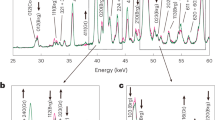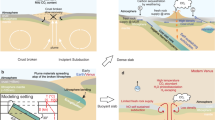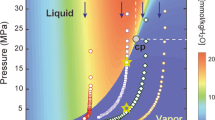Abstract
Why Venus lacks plate tectonics remains an unanswered question in terrestrial planet evolution. There is observational evidence for subduction—a requirement for plate tectonics—on Venus, but it is unclear why the features have characteristics of both mantle plumes and subduction zones. One explanation is that mantle plumes trigger subduction. Here we compare laboratory experiments of plume-induced subduction in a colloidal solution of nanoparticles to observations of proposed subduction sites on Venus. The experimental fluids are heated from below to produce upwelling plumes, which in turn produce tensile fractures in the lithosphere-like skin that forms on the upper surface. Plume material upwells through the fractures and spreads above the skin, analogous to volcanic flooding, and leads to bending and eventual subduction of the skin along arcuate segments. The segments are analogous to the semi-circular trenches seen at two proposed sites of plume-triggered subduction at Quetzalpetlatl and Artemis coronae. Other experimental deformation structures and subsurface density variations are also consistent with topography, radar and gravity data for Venus. Scaling analysis suggests that this regime with limited, plume-induced subduction is favoured by a hot lithosphere, such as that found on early Earth or present-day Venus.
This is a preview of subscription content, access via your institution
Access options
Access Nature and 54 other Nature Portfolio journals
Get Nature+, our best-value online-access subscription
$29.99 / 30 days
cancel any time
Subscribe to this journal
Receive 12 print issues and online access
$259.00 per year
only $21.58 per issue
Buy this article
- Purchase on Springer Link
- Instant access to full article PDF
Prices may be subject to local taxes which are calculated during checkout






Similar content being viewed by others
References
Noack, L. et al. Can the interior structure influence the habitability of a rocky planet? Planet. Space Sci. 98, 14–29 (2014).
Smrekar, S. E. et al. in Exploring Venus as a Terrestrial Planet (eds Esposito, L. W., Stofan, E. R. & Cravens, T. E.) 43–72 (AGU Geophysical Monograph 176, 2007).
Crameri, F. B. & Kaus, J. P. Parameters that control lithospheric—scale thermal localization on terrestrial planets. Geophys. Res. Lett. 37, L09308 (2010).
Bercovici, D. & Ricard, Y. Plate tectonics, damage and inheritance. Nature 508, 513–516 (2014).
McKenzie, D. et al. Features on Venus generated by plate boundary processes. J. Geophys. Res. 97, 13533–13544 (1992).
Sandwell, D. T. & Schubert, G. Evidence for retrograde lithospheric subduction on Venus. Science 257, 766–770 (1992).
Hansen, V. L. & Olive, A. Artemis, Venus: the largest tectonomagmatic feature in the solar system? Geology 38, 467–470 (2010).
Sandwell, D. T. & Schubert, G. Flexural ridges, trenches, and outer rises around coronae on Venus. J. Geophys Res. 97, 16069–16083 (1992).
Niu, Y., O’Hara, M. J. & Pearce, J. Initiation of subduction zones as a consequence of lateral compositional buoyancy contrast within the lithosphere: a petrological perspective. J. Petrol. 44, 851–866 (2003).
Whattam, S. A. & Stern, R. J. Late Cretaceous plume-induced subduction initiation along the southern margin of the Caribbean and NW South America: the first documented example with implications for the onset of plate tectonics. Gondwana Res. 27, 38–63 (2015).
Burov, E. & Cloetingh, S. Plume-like upper mantle instabilities drive subduction initiation. Geophys. Res. Lett. 37, L03309 (2010).
Ueda, K., Gerya, T. & Sobolev, S. V. Subduction initiation by thermal–chemical plumes: numerical studies. Phys. Earth Planet. Inter. 171, 296–312 (2008).
Gerya, T. V., Stern, R. J., Sobolev, S. V. & Whattam, S. A. Plate tectonics on the Earth triggered by plume-induced subduction initiation. Nature 527, 221–225 (2015).
Stofan, E. R., Bindschadler, D. L., Head, J. W. & Parmentier, E. M. Coronae on Venus: models of origin. J. Geophys. Res. 96, 20933–20946 (1991).
Smrekar, S. E. & Stofan, E. R. Coupled upwelling and delamination: a new mechanism for coronae formation and heat loss on Venus. Science 277, 1289–1294 (1997).
Piskorz, D., Elkins-Tanton, L. T. & Smrekar, S. E. Coronae formation on Venus via extension and lithospheric instability. J. Geophys. Res. 119, 2568–2582 (2015).
Hoogenboom, T. & Houseman, G. A. Rayleigh–Taylor instability as a mechanism for corona formation on Venus. Icarus 180, 292–307 (2006).
Dombard, A. J., Johnson, C. L., Richards, M. A. & Solomon, S. C. A magmatic loading model for coronae on Venus. J. Geophys. Res. 112, E04006 (2007).
Gerya, T. V. Plume-induced crustal convection: 3D thermomechanical model and implications for the origin of novae and coronae on Venus. Earth Planet. Sci. Lett. 391, 183–192 (2014).
Brown, C. D. & Grimm, R. E. Tectonics of Artemis Chasma: a Venusian ‘plate’ boundary. Icarus 117, 219–249 (1995).
Schubert, G. & Sandwell, D. T. A global survey of possible subduction sites on Venus. Icarus 117, 173–196 (1995).
Fowler, A. C. & O-Brien, S. B. G. A mechanism for episodic subduction on Venus. J. Geophys. Res. 101, 4755–4763 (1996).
Hansen, V. L. & Phillips, R. J. Tectonics and volcanism of Eastern Aphrodite Terra, Venus: no subduction no spreading. Science 260, 526–530 (1993).
Goldfinger, C. et al. Transverse structural trends along the Oregon convergent margin: implications for Cascadia earthquake potential and crustal rotations. Geology 20, 141–144 (1992).
Di Giuseppe, E., Davaille, A., Mittelstaedt, E. & François, M. Rheological and mechanical properties of silica colloids: from Newtonian liquid to brittle behavior. Rheol. Acta 51, 451–465 (2012).
Müller, G. Starch columns: analog model for basalt columns. J. Geophys. Res. 103, 15239–15253 (1998).
Amiri, A., Oye, G. & Sjöblom, J. Temperature and pressure effects on stability and gelation properties of silica suspensions. Colloids Surf. 378, 14–21 (2011).
Schubert, G., Turcotte, D. L. & Olson, P. Mantle Convection in the Earth and Planets (Cambridge Univ. Press, 2001).
Olson, P. & Nam, I. S. Formation of seafloor swells by mantle plumes. J. Geophys. Res. 91, 7181–7191 (1986).
Griffths, R. W., Gurnis, M. & Eitelberg, G. Holographic measurements of surface topography in laboratory models of mantle hotspots. Geophys. J. 96, 1–19 (1989).
Koch, D. M. & Manga, M. Neutrally buoyant diapirs: a model for Venus coronae. Geophys. Res. Lett. 23, 225–228 (1996).
Kemp, D. V. & Stevenson, D. J. A tensile, flexural model for the initiation of subduction. Geophys. J. Int. 125, 73–94 (1996).
Vermorel, R., Vandenberghe, N. & Villermaux, E. Radial cracks in perforated thin sheets. Phys. Rev. Lett. 104, 175502 (2010).
Olson, P., Schubert, G., Anderson, C. & Goldman, P. Plume formation and lithosphere erosion: a comparison of laboratory and numerical experiments. J. Geophys. Res. 93, 15065–15084 (1988).
Androvandi, S., Davaille, A., Limare, A., Fouquier, A. & Marais, C. At least three scales of convection in a mantle with strongly temperature-dependent viscosity. Phys. Earth Planet. Inter. 188, 132–141 (2011).
Schmalholz, S. M. A simple analytical solution for slab detachment. Earth Planet. Sci. Lett. 304, 45–54 (2011).
Kohlstedt, D. L., Evans, B. & Mackwell, S. J. Strength of the lithosphere: constraints imposed by laboratory experiments. J. Geophys. Res. 100, 17587–17602 (1995).
Hansen, V. L. Artemis: signature of a deep mantle plume on Venus. Geol. Soc. Am. Bull. 114, 839–848 (2002).
Ivanov, M. & Head, J. W. Lada Terra rise and Quetzalpetlatl Corona: a region of long-lived mantle upwelling and recent volcanic activity on Venus. Planet. Space Sci. 58, 1880–1894 (2010).
Brown, C. D. & Grimm, R. E. Lithospheric rheology and flexure at Artemis Chasma, Venus. J. Geophys. Res. 101, 12697–12708 (1996).
Tanimoto, T. State of stress within a bending spherical shell and its implications for subducting lithosphere. Geophys. J. Int. 134, 199–206 (1998).
Kratter, K. M., Carter, L. M. & Campbell, D. B. An expanded view of Lada Terra, Venus: new Arecibo radar observations of Quetzalpetlatl Corona and surrounding flows. J. Geophys. Res. 112, E04008 (2007).
Helbert, J., Müller, N., Kostama, P., Piccioni, G. & Drossart, P. Surface brightness variations seen by VIRTIS on Venus Express and implications for the evolution of the Lada Terra region, Venus. Geophys. Res. Lett. 35, L11201 (2008).
Smrekar, S. E. et al. Recent hotspot volcanism on Venus from VIRTIS emissivity data. Science 328, 605–608 (2010).
Schubert, G., Moore, W. B. & Sandwell, D. T. Gravity over coronae and chasmata on Venus. Icarus 112, 130–146 (1994).
Armann, M. & Tackley, P. J. Simulating the thermochemical magmatic and tectonic evolution of Venus’s mantle and lithosphere: two-dimensional models. J. Geophys. Res. 117, E12003 (2012).
Crameri, F. & Tackley, P. J. Subduction initiation from a stagnant lid and global overturn: new insights from numerical models with a free surface. Prog. Earth Planet. Sci. 3, 30 (2016).
Moresi, L. & Solomatov, V. Mantle convection with a brittle lithosphere: thoughts on the global tectonic styles of Earth and Venus. Geophys. J. Int. 133, 669–682 (1998).
Bjonnes, E. E., Hansen, V. L., James, B. & Swenson, J. B. Equilibrium resurfacing of Venus: results from new Monte Carlo modeling and implications for Venus surface histories. Icarus 217, 451–461 (2012).
O’Rourke, J. G., Wolf, A. S. & Ehlmann, B. L. Venus: interpreting the spatial distribution of volcanically modified craters. Geophys. Res. Lett. 41, 8252–8260 (2014).
Brown, L. A., Zukoski, C. F. & White, L. R. Consolidation during drying of aggregated suspensions. AIChE J. 48, 492–502 (2002).
Style, R. W. & Peppin, S. S. L. Crust formation in drying colloidal suspensions. Proc. R. Soc. A 467, 174–193 (2011).
Morris, S. & Canright, D. R. A boundary-layer analysis of Benard convection with strongly temperature-dependent viscosity. Phys. Earth Planet. Inter. 36, 355–373 (1984).
Davaille, A. & Jaupart, C. Transient high-Rayleigh number thermal convection with large viscosity variations. J. Fluid Mech. 253, 141–166 (1993).
Solomatov, S. Scaling of temperature- and stress-dependent viscosity convection. Phys. Fluids 7, 266–274 (1995).
Petersen, R. I., Stegman, D. R. & Tackley, P. J. A regime diagram of mobile lid convection with plate-like behavior. Phys. Earth Planet. Inter. 241, 65–76 (2015).
Fourel, L., Goes, S. & Morra, G. The role of elasticity in slab bending. Geochem. Geophys. Geosyst. 15, 4507–4525 (2014).
Schmalholz, S. M. & Podladchikov, Y. Buckling versus Foldin: importance of viscoelasticity. Geophys. Res. Lett. 26, 2641–2644 (1999).
Boulogne, F., Giorgutti-Dauphiné, F. & Pauchard, L. The buckling and invagination process during consolidation of colloidal droplets. Soft Matter 9, 750–757 (2014).
Demouchy, S., Tommasi, A., Barou, F., Mainprice, D. & Cordier, P. Deformation of olivine in torsion under hydrous conditions. Phys. Earth Planet. Inter. 202–203, 56–70 (2012).
Demouchy, S., Tommasi, A., Boffa-Ballaran, T. & Cordier, P. Low strength of Earth’s uppermost mantle inferred from tri-axial deformation experiments on dry olivine crystals. Phys. Earth Planet. Inter. 220, 37–49 (2013).
Crameri, F. & Tackley, P. J. Parameters controlling dynamically self-consistent plate tectonics and single-sided subduction in global models of mantle convection. J. Geophys. Res. 120, 3680–3706 (2015).
Korenaga, J. Thermal cracking and the deep hydration of oceanic lithosphere: a key to the generation of plate tectonics? J. Geophys. Res. 112, B05408 (2007).
Montesi, G. J. Fabric development as the key for forming ductile shear zones and enabling plate tectonics. J. Struct. Geol. 50, 254–266 (2013).
Brace, W. F. & Kohlstedt, D. L. Limits on lithospheric stress imposed by laboratory experiments. J. Geophys. Res. 85, 6248–6252 (1980).
Li, Z.-H. & Ribe, N. M. Dynamics of free subduction from 3-D boundary element modeling. J. Geophys. Res. 117, B06408 (2012).
Govers, R. & Wortel, M. J. R. Lithosphere tearing at STEP faults: response to edges of subduction zones. Earth Planet. Sci. Lett. 236, 505–523 (2005).
Hale, A. J. et al. Dynamics of slab tear faults: insights from numerical modelling. Tectonophysics 483, 58–70 (2010).
Nijholt, N. & Govers, R. The role of passive margins on the evolution of Subduction-Transform Edge Propagators (STEPs). J. Geophys. Res. 120, 7203–7230 (2015).
Gurnis, M., Zhong, S. & Toth, J. in The History and Dynamics of Global Plate Motions (eds Richards, M. A., Gordon, R. & van der Hilst, R.) 73–94 (AGU Geophysical Monograph 21, 2000).
Telford, W. M., Geldart, L. P., Sheriff, R. E. & Keys, D. A. Applied Geophysics 43 (Cambridge Univ. Press, 1976).
Wieczorek, M. A. Treatise on Geophysics Vol. 10, 165–206 (Elsevier, 2007).
Audet, P. Directional wavelet analysis on the sphere: application to gravity and topography of the terrestrial planets. J. Geophys. Res. 116, E01003 (2011).
James, P. B., Zuber, M. T. & Phillips, R. J. Crustal thickness and support of topography on Venus. J. Geophys. Res. 118, 859–875 (2013).
Acknowledgements
Part of this research was carried out at the Jet Propulsion Laboratory, California Institute of Technology, under a contract with the National Aeronautics and Space Administration. S.E.S. was supported by Jet Propulsion Laboratory internal funds, and A.D. by grants from PNP-INSU and the French ANR ‘PTECTO’ (ANR-09-BLAN-0142). A.D. is grateful for the technical support of A. Aubertin, R. Pidoux and L. Auffray.
Author information
Authors and Affiliations
Contributions
A.D. carried out the laboratory experiments, determined the scaling laws, and proposed the geodynamical model for Venus plume-induced subduction. S.E.S. chose Venusian analogue sites and analysed image data. S.T. analysed gravity and topography data. S.E.S. and A.D. wrote the manuscript.
Corresponding author
Ethics declarations
Competing interests
The authors declare no competing financial interests.
Supplementary information
Supplementary Information
Supplementary Information (PDF 5373 kb)
Supplementary Information
Supplementary Information (MOV 9485 kb)
Rights and permissions
About this article
Cite this article
Davaille, A., Smrekar, S. & Tomlinson, S. Experimental and observational evidence for plume-induced subduction on Venus. Nature Geosci 10, 349–355 (2017). https://doi.org/10.1038/ngeo2928
Received:
Accepted:
Published:
Issue Date:
DOI: https://doi.org/10.1038/ngeo2928
This article is cited by
-
The importance of continents, oceans and plate tectonics for the evolution of complex life: implications for finding extraterrestrial civilizations
Scientific Reports (2024)
-
Dyke swarms record the plume stage evolution of the Atla Regio superplume on Venus
Communications Earth & Environment (2023)
-
Earth-like lithospheric thickness and heat flow on Venus consistent with active rifting
Nature Geoscience (2023)
-
Long-lived volcanic resurfacing of Venus driven by early collisions
Nature Astronomy (2023)
-
Synergies Between Venus & Exoplanetary Observations
Space Science Reviews (2023)



